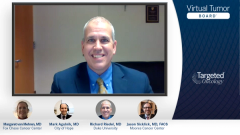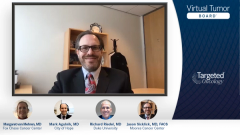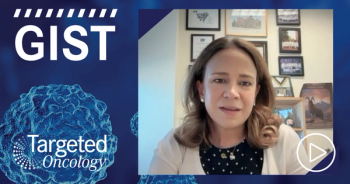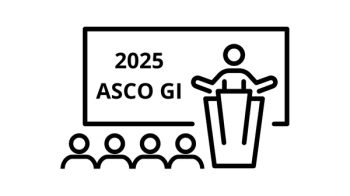
Case 2: VOYAGER and INTRIGUE Trials
A panel of experts review the VOYAGER and INTRIGUE trials.
Episodes in this series

Richard Riedel, MD: Mark, for this case, we have an individual who has progressed on 2 lines of therapy and didn’t tolerate a third line all that well. What other options could we consider?
Mark Agulnik, MD: I tend to follow the FDA guidelines. Certainly, for fourth-line therapy I would use ripretinib. Prior to the introduction of ripretinib into the market, I would pull from other TKIs [tyrosine kinase inhibitors] that we’ve seen some level of activity in other phase 1 and 2 studies, posters that have been presented at ASCO [American Society of Clinical Oncology Annual Meeting] or CTOS [Connective Tissue Oncology Society]. But in 2021, I would go with FDA guidelines.
Richard Riedel, MD: Question for the panel. Have there been any trials recently that have tried to incorporate novel therapies into the realm that may be of interest?
Margaret von Mehren, MD: There was the study that looked at avapritinib and compared it with regorafenib in the third-line setting for patients who had progressed on imatinib and sunitinib. Avapritinib was designed to address some of those mutations that are not well handled by sunitinib, regorafenib, or imatinib. Jason, do you want to speak to that in terms of those mutations?
Jason Sicklick, MD, FACS: Avapritinib was designed as a PGFR alpha–targeting agent. We know that somewhere about 10%, perhaps even up to 15% of the gastric GISTs [gastrointestinal stromal tumors] will have a PGFRA mutation. We can frequently see those with small-bowel GIST or rectal GIST, so they’re often in the stomach in terms of their primary location.
Margaret von Mehren, MD: In terms of thinking about a lot of the mutations that are resistant to Sutent and regorafenib are the ones found in what we call the activation loop. Avapritinib was really designed not only for PGFRA but for these mutations in the activation loop, which are more common in the PGFRA GIST. This study was hoping that the patients would be more likely to have tumors that had these mutations, so they might have an advantage with the avapritinib compared with regorafenib. That was the thought process behind the design of this trial.
Richard Riedel, MD: Meg, this trial came on the heels of a phase 1 study that showed some promising activity in the fourth-line setting and beyond. The thought was, well, perhaps we could move avapritinib into an earlier-line therapy—in this case, third-line therapy vs regorafenib, which as we’ve articulated quite a bit can be challenging. The hope would be that it improves outcomes.
Unfortunately, as we’ve heard recently, the study did not meet its primary end point. The primary end point was progression-free survival. At least in the phase 3 study there was no significant improvement for the use of avapritinib over standard of care, which was regorafenib, as it relates to progression-free survival.
Interestingly, response rate was improved with avapritinib. In the intent-to-treat analysis it was about 17% overall response rate with all those being partial responses, less than 10% for regorafenib.
Margaret von Mehren, MD: That echoed what was seen in the phase 1 study in terms of response rate.
Richard Riedel, MD: The disease control rate, despite the improvement in partial responses, was similar between the 2 medications. Interestingly, despite improvement in response rate, the median duration of response was not improved with avapritinib. A little disappointing. Some encouraging data in the fourth-line setting and beyond with respect to response rate, but they missed the mark with respect to progression-free survival. Overall survival was premature.
The adverse-effect profile for avapritinib did show some differences compared with regorafenib. There was more anemia but less hand-foot syndrome, less hypertension. Some differing adverse effects, none of which, however, we don’t routinely see in clinic.
Mark Agulnik, MD: What we need to highlight for this is that for every drug we use as we move into our fifth drug, we do have to look at what is different from the other ones. When I counsel my patients, I try to bring in caregivers for this because of the neurocognitive changes you could see with it, so caregivers should watch for and be cognizant of any changes and then to bring it to the team if these neurocognitive changes come about.
I’ll also just highlight what we talked about before: “Do I feel comfortable doing placebo?” If I’m not mistaken, this is the first head-to-head study we’ve done in this disease. It is over maybe 470 patients, so we could get a robust number of patients. We could do it globally, which 20%—maybe plus—was in Asia, and we could get them done quickly. We have the patients. We have the people interested, and this highlights in the sarcoma community our real desire to move things forward for our patients.
Margaret von Mehren, MD: To follow up on that, just recently closed is the study that compared sunitinib with ripretinib. The idea behind that was the way this drug works, which is different from all the others. In the early studies showing—we talked about this in the first case—some activity in earlier lines of therapy asking the question in a well-powered, randomized way: Is ripretinib better than sunitinib in that second-line setting?
Richard Riedel, MD: The mechanism of action for ripretinib is a bit different from that for avapritinib. Correct?
Margaret von Mehren, MD: Yes. Ripretinib binds the kinase in 2 spots and prevents it from becoming activated, whereas the other agents we’ve used essentially bind the activated confirmation and prevent the kinase from being functional. Very different mechanisms.
Richard Riedel, MD: Similar to what was seen with avapritinib in the fourth-line setting and beyond, what’s called the phase 1 NAVIGATOR study, ripretinib also showed promising data in early-phase studies in various lines of therapy, so in second-line therapy, third-line therapy in addition to fourth-line therapy. Again, at least some data to suggest that moving some of these novel therapies earlier may benefit patients.
Obviously, we’ve talked about the VOYAGER study, which was the third-line study on avapritinib vs regorafenib that did not pan out. Meg, you alluded to the INTRIGUE study, which is the study of ripretinib in second-line setting vs sunitinib. Would you like to briefly discuss the study design?
Margaret von Mehren, MD: Yes. It’s an open-label study in part because the drugs are different in different ways. Sunitinib is being prescribed based on the FDA-labeled dosing, which is 50 mg daily for 4 weeks on, 2 weeks off and compared with ripretinib 150 mg daily. Patients were randomized 1:1 and continued therapy until progression.
There was not a crossover design in this study, in part because there is a standard third-line therapy that is effective. It was felt that at this point, without more data, it was inappropriate to offer the crossover.
Richard Riedel, MD: Mark, as you pointed out, the previous study with avapritinib vs regorafenib was a large study. The INTRIGUE study looking at ripretinib vs sunitinib in the second-line setting was a large study, about 350 patients. It speaks to our ability despite being a rare disease to accrue through international collaboration.
Mark Agulnik, MD: One hundred percent. It takes the world in this situation, and the use of some of these patient advocacy groups and online sites really will help drive the patients to these academic centers to get on these trials so that we could answer the questions and get new drugs to market for them.
Richard Riedel, MD: With that we’ll finish this case. I would conclude this section by saying the future is bright for GIST with some of these novel therapies with novel mechanisms of action and certainly encouraging data in the more heavily pretreated patient population. As was mentioned, moving these therapies to earlier lines really needs to be done in a prospective fashion, but coming together as an international sarcoma and GIST community, we’re able to do these studies. Obviously anxiously awaiting these results to see if we can impact and change the care of our patients.
Transcript edited for clarity.












































